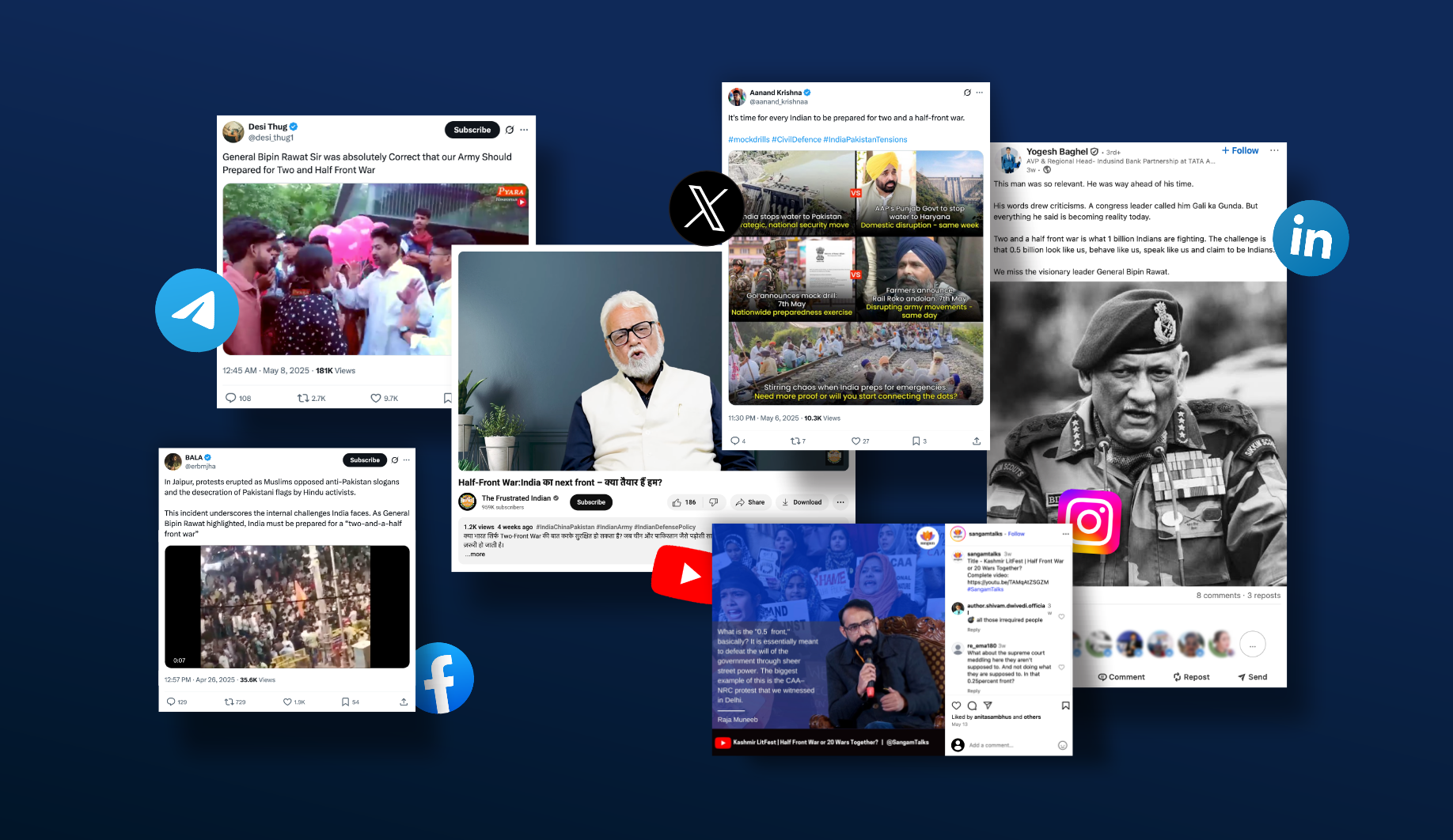On April 22, a terrorist attack killed 25 Indian tourists and one local resident in Pahalgam, Jammu and Kashmir. Alongside the devastating human toll, the attack triggered a surge of hate targeting Kashmiris in particular and Muslims more broadly. Hate rallies quickly spread on the ground, and virtual platforms became vectors for hate speech. Inflammatory songs calling for Muslims to leave India were circulated widely online, and Muslim-owned businesses were vandalized in multiple states.
In the aftermath, India launched “Operation Sindoor,” conducting missile and drone strikes across multiple locations in Pakistan. Yet a more insidious development was simultaneously unfolding in Hindu nationalist ecosystem online: the resurrection and political repurposing of the “two-and-a-half front war” doctrine.
Originally articulated by India’s late Chief of Defence Staff (CDS) General Bipin Rawat, the doctrine envisioned India preparing for simultaneous military conflicts with Pakistan and China (the two full fronts), while also addressing internal security threats like insurgency and terrorism (the “half-front”). This doctrine has been repurposed by the Hindu nationalists, turning it into a weapon against India’s own citizens including Muslim citizens whose loyalty to the nation is repeatedly questioned, civil society activists, political opposition leaders, and anyone critical of the ruling government and its Hindu nationalist ideology.
Over time, this “half-front” framing has become a recurring motif in Hindu nationalist discourse. From parliamentary speeches to coordinated social media campaigns, dissenters are now routinely branded as “anti-national,” “urban Naxals” (a term used for alleged Maoist sympathizers), or worse — traitors in league with foreign adversaries like Pakistan or China. The term has gained increasing traction online, especially in the wake of the recent hostilities between India and Pakistan.
The Half-Front Rhetoric
Since the start of the current cross-border conflict, Bharatiya Janata Party (BJP) supporters and Hindu nationalist media outlets have weaponized the “half-front” language to delegitimize dissent. Far-right websites like OpIndia have invoked General Rawat’s warning but have gone a step further by explicitly accusing internal critics of the government of waging “psychological and ideological warfare” on behalf of enemy nations.
An OpIndia article published after the ceasefire between India and Pakistan alleged that Muslim youths in India were supportive of Pakistan, stating: “Their loyalty is rooted in their religious convictions rather than their national identity, which causes them to overlook ethical considerations and even support terrorism under the guise of ideological similarity. They have periodically expressed their malicious loyalties to undermine the nation’s morale, particularly during crucial moments when India requires the steadfast support of its citizens.”
Scattered incidents — such as Muslim youth allegedly posting objectionable content, images of the Pakistani flag, or slogans like “Pakistan Zindabad” — were used to justify sweeping generalizations. In one case cited in the report, a young man who shared an image of the ‘Army of Mahdi,’ an Iraqi Shia militia group, was falsely represented as supportive of Pakistan. It also cited arrests made by police in different parts of India, including Madhya Pradesh and Uttar Pradesh states, as evidence of pro-Pakistan activities by Muslims.
The vicious nature of this rhetoric is even more explicit on social media platforms where BJP supporters and Hindu nationalist influencers routinely call for stripping dissenters of constitutional protections. Critics who questioned the government’s failure to prevent the Pahalgam attack were labelled internal enemies. Others who questioned the efficacy and long-term implications of hostilities were branded ‘Pakistani mouthpieces.’ Even fact-checkers debunking misinformation during the crisis were attacked and described as part of a “Pakistani fifth column.”
Hindu nationalist influencers online referred to fact-checkers combating misinformation and disinformation during the conflict “Pakistani 5th column.” The smear campaign extended to unrelated issues: sikh farmers protesting policies were accused of sabotaging national unity, and opposition leaders were framed as acting in Pakistan’s interest. BJP leader Amit Malaviya even questioned whether Congress leader Rahul Gandhi was aiming for Pakistan’s highest civilian award, the Nishan-e-Pakistan.
War Against India Itself
The implications of this rhetoric are authoritarian at their core. This framing casts minorities and critics not as fellow citizens, but as threats to national integrity. By equating peaceful dissent and social justice advocacy with terrorism and treason, Hindu nationalist forces create a framework that justifies surveillance, arbitrary detention, and censorship.
India’s already vague and expansive national security laws, like the Unlawful Activities (Prevention) Act (UAPA), the National Security Act (NSA), and sedition, have been used to jail journalists, student leaders, and activists.
Amidst the ongoing hostilities, the Indian government launched a sweeping crackdown on the press and its critics. X (formerly Twitter) stated that it had received executive orders to restrict nearly 8,000 accounts, including those of Indian users and independent news outlets such as The Kashmiriyat, Free Press Kashmir, and Maktoob Media. The Wire reported that access to its website was blocked across India following government directives under the IT Act, 2000.
The arrest of Muslim professor Ali Khan Mahmudabad — charged with sedition over a social media post about the conflict — is emblematic of this broader pattern. The state has also used the cover of conflict to target Muslims by labeling them as Bangladeshi nationals. Thousands have been detained, makeshift homes of mostly Muslim migrant workers have been demolished and Muslim citizens in Assam state have been pushed across the border into Bangladesh.
Some Hindu nationalist supporters have gone so far as to frame the conflict as a battle between one billion Indians and 400 million minorities. This is not a national security doctrine but an ideological infrastructure of a civil war against minorities and dissenters.
What is unfolding amounts to a Hindu nationalist war against India itself, especially its minorities and most marginalized communities. The cost is not just borne by Muslims, Dalits, Adivasis, and dissenters; it is borne by the republic itself. If this trajectory continues, the greatest casualty of this war will not be India’s enemies, but the very idea of India.
(Aishik Saha is a Trust and Safety Researcher (TSR))
